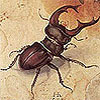Выдержка из книги
И.А.Ефремова "Лезвие бритвы":"Над столом и диваном привлекали внимание большие репродукции картин. Громадный африканский слон важно шествовал по степи, взмахивая тонким хвостиком. Другой слон, ещё больше, бежал прямо на зрителя, растопырив чудовищные уши и подняв грозные бивни. Животное спасалось от взвивавшегося за ним вихревым столбом степного пожара. Чёрный буйвол стоял в перемятом тростнике, принюхиваясь к чему-то, одинокий и сумрачный. Животные, изображённые с невиданной выразительностью, невольно приковывали взгляд, и Сима не сразу заметила большую репродукцию портрета балерины.
— Что это за художник? — спросила она, опускаясь в неудобное современное, не дававшее поддержки голове, кресло.
— Вильгельм Кунерт. Так преходяща слава творцов искусства, избравшего своей темой природу, а не человека.
— Дело в моей необразованности, а вовсе не в судьбе искусства.
— Не вы первая и не вы последняя! Кунерт, знаменитый африканский путешественник и художник, был первым, кто создал картины животных Африки, вошедшие во все учебники.
— Тогда я припоминаю.
— Теперь все его усилия оказались ненужными. Чудеса фотографии и киносъёмки с телеобъективами сделали возможным получение таких портретов животных, о каких и не мечталось Кунерту. А прошло всего лет пятьдесят. Последние картины Кунерт писал в начале нашего века, пока не застрелился.
— Он покончил с собой?
— Когда убедился, что больше не может ездить в Африку и любить молодую красавицу жену, он выстрелил себе в голову из слонового ружья, верно служившего ему в Африке. Это было надёжно!"
____________
Wilhelm Kuhnert was born in 1865 in Oppel (Silesia) and died in 1926 in Flims (Switzerland). He studied at the Royal Academy of Fine Arts, then turned towards the study of nature. Wilhelm Kuhnert, the leading classical painter of the tropical animal world, is also commonly known as “Lion-Kuhnert”. His favourite motif was and continued to be the lion – the king of the animals. But on no account was his work limited to that motif. With his inimitable art of portrayal, he captured animals and human beings as he saw and experienced them on his many journeys.
He gained the most intimate knowledge of the animal world and countryside on many study trips through Europe, Africa and Asia. They played a dominating role for the free development of is realistic painting. Countless sketches and drawings were the artistic yield. From that he created, aided by his visual memory, his greatest works. All of them of grand beauty and unique expressiveness.
Only a few works are accessible to the public in museums in Fort Worth (USA), Enschede and Leiden (Netherlands). Most pieces are in private hands.
Because of this, I see it as my duty to make reproductions of elected works and the available original etchings of my grandfather accessible to an interested circle of people.
A well-known appreciator writes:
“I have no right to judge on Wilhelm Kuhnert as an artist. But I can describe the impression his works had on me.
I had passed East-Africa in months of journeys, had been climbing through the primeval forest belt at Mount Kilimanjaro, and had seen the tracks of the lion and the antelope in the snow. In the papyrus-swamps at the foot of the mountain, I had observed marabous and cranes, in the steppe different species of antelopes and gazelles and had often heard the hunt call of the lion at night in the wide plain. Also, the defending buffalo I had stalked, and had crawled towards a bull up to 34 steps and had killed it. At Lake Rukwa I had rescued the natives from some dangerous crocodiles. The enormous nature of Africa and its animal world impressed me deeply and I could hardly digest it all.
Then I came to Iringa and saw on the walls of the old fortress what I had faced before. But it was more beautiful, exquisite, and at the same time more authentic than what I had seen. It was seen through the eyes of a really great artist, captured with the deepest soul, and pictured with incredible skills.
The artist of these images was Wilhelm Kuhnert. You have to see his work. It is impossible to describe it in an adequate way.”
Paul v. Lettow-Vorbeck
link
